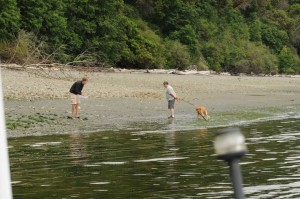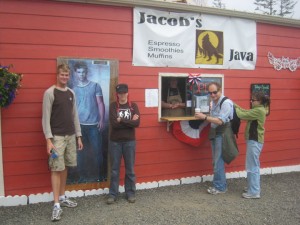Two college students, six days, 250 sea stars, and one Garmin GPS.
Over the week of July 9-15, my research partner, Stephen, and I made a tour of beaches between Commencement Bay and La Push, WA, conducting sea star surveys and performing gull predation trials. Here are some photo highlights and a few anecdotes you may enjoy.

Stephen Reller holds up two six-pound sea stars!
At Observatory Point, we were first discouraged by the lack of sea stars in the usual habitat: under rocks in the intertidal. But as we moved toward the point, rocks were covered with huge californianis mussels, and what comes with huge mussels? Huge sea stars. The largest Pisaster we found was over six pounds and bigger than my torso. Needless say, hauling four buckets of those guys back to the car for analysis was quite the task (especially since they didn’t actually fit in the buckets) and drew a bit of attention from the other beach goers, including the Fish and Wildlife game warden counting everyone’s catch. Fortunately, a particularly enthusiastic friend we made on the beach hurried to warn the warden while we were still struggling back to the parking lot that our particular “catch” was a bit odd but perfectly legal.

This guy walked his dog right into the middle of my predation trial, scaring away ALL the gulls I was trying to test. Alas, public interest.
Speaking of attention from the general public. As researchers working in public locations, we often have the opportunity to answer a lot of “what are you doing” questions. Usually people just listen politely, wish us luck, and leave us alone. Usually. Other times their well-intending interest gets a bit in the way, like this kind fellow who, in trying to find out what we were doing, led his dog right into the middle of my predation trial transect and scared away ALL of the gulls we were trying to test.

Imitating the bryophyte-burdened gymnosperms behind us. I am the tree, Stephen is the moss.
Early tides on the coast meant that our work days were usually over by around 2:00 pm, so we spent our evenings exploring a new part of Washington, hiking, playing on beaches, and reading in the sun. After surveying Mora Beach in La Push, WA, we took a slight detour down to the Hoh Rainforest. The trails were packed with German tourists and Twilight Girls, but that didn’t stop Stephen and I from being our childish selves, as captured by Joel Elliott below, impersonating the impressive moss on the Moss Trail.
Back to the “Twilight Girls”. Our trip took us right through the heart of Twilight country. I proudly admit that I am the only one in our group (Stephen, Professor Elliott, and myself) who has not read the Stephenie Meyer saga, but I could still see evidence of the pop-culture pox on the small Quileute community. For one morning coffee, Joel had us stop at “Jacob’s Java”, a small esspresso stand sporting a life-size poster of the shirtless werewolf who has come to represent the area. Needless to say, we posed for pictures (some of us less willingly than others).

- Stephen and Mary pose at “Jacob’s Java”. I think the barista is laughing at us.
And when we weren’t posing for pictures and playing tourists, we also did some science. Among the beaches we visited were Port Townsend, Observatory Point, Slip Point, Hobuck Beach, Shi-shi Beach, and Mora Beach. At all of these sites we performed thorough surveys of sea star populations. We collected our species of interest, Pisaster ochraceus, and brought them back to our “Mobile Command Center” for analysis. In most places Mobile Command was the back of Stephen’s car, but occasionally I was stuck in a tent with the screaming light source of my spectrophotometer to analyze the color of our dozens of collected specimens. I’m not bitter, but I do think I lost a few brain cells.

Mary at Mobile Command using a spectrophotometer to analyze color of Pisaster ochraceus.
